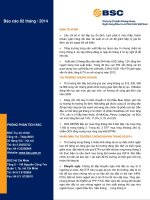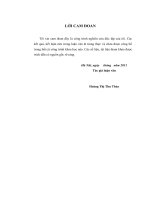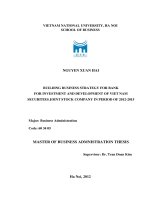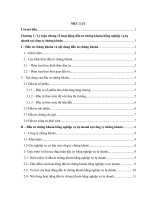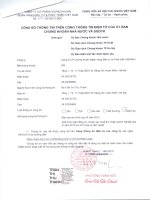Xây dựng chiến lược kinh doanh cho công ty cổ phần chứng khoán Ngân hàng Đầu tư và phát triển Việt Nam giai đoạn 2012-2015
Bạn đang xem bản rút gọn của tài liệu. Xem và tải ngay bản đầy đủ của tài liệu tại đây (844.78 KB, 100 trang )
VIETNAM NATIONAL UNIVERSITY, HA NOI
SCHOOL OF BUSINESS
NGUYEN XUAN HAI
BUILDING BUSINESS STRATEGY FOR BANK
FOR INVESTMENT AND DEVELOPMENT OF VIET NAM
SECURITIES JOINT STOCK COMPANY IN PERIOD OF 2012-2015
Major: Business Administration
Code: 60 34 05
MASTER OF BUSINESS ADMNISTRATION THESIS
Supervisor: Dr. Tran Doan Kim
Ha Noi, 2012
ii
ABSTRACT
BUILDING BUSINESS STRATEGY FOR BANK
FOR INVESTMENT AND DEVELOPMENT OF VIET NAM
SECURITIES JOINT STOCK COMPANY IN PERIOD OF 2012-2015
Nguyen Xuan Hai
MBA Candidate, 2008-2010
Hanoi School of Business, Vietnam National University
Supervisor: Dr. Tran Doan Kim
December 2012, 91 pages
The world economy has been in more stable phase after economic crisis and is
having significant development. Together with general development trend of the
world economy, Vietnam is gradually marking position in global economy. With
the open economy, demand on capital in regard to enterprises increases and become
diversified. Securities market, by means of a part of market. It is useful took to
solve demand on capital.
After 11 years of foundation and development, securities market in Vietnam has
gained significant achievements and steps. At present, there are more than 100
securities companies and each of them self-drives to survive and develop after ups
and downs in market. The ups and downs of market in 2010 and first half of 2012
have made some securities companies recognize efficiency and adjust their trading
activities. BIDV Securities Joint Stock Company (BSC) is one of the first securities
companies adjusting their development strategy to be able to have improvement in
securities market.
With open tendency of economy, BSC has to face up with more and more rivals not
only domestic ones but also foreign one with strong finance capacity. The increase
of rivals reduces market share of BSC. Although BSC has many competitive
iii
advantages namely strong finance capacity and trademark and over the past years,
BSC always improves to increase prestige and product quality provided customers;
BSC must have development strategy in the future against fiercely competitive
pressure as present. If applicable, the company can control risks, solid steps and
mark position in Vietnam Securities market.
In the condition of the difficulties of the economy, the securities industry has faced
up to huge challenges. Developing strengths, eliminating weaknesses, promoting
the absolute advantage and competitive advantage will help the businesses in the
field of securities find the way to survive and develop in the current period. Which
direction should be selected? what strategy should be chosen? The limitation of
resources and the current period is extremely difficult for securities companies.
Thanks to discussions with experts in the field of securities as well as colleagues,
leaders in the BSC and the knowledge achieved from the course, the author has
contributed a little to find out strategy and direction for the BSC in the future. With
all the general information about the stock market, the author would like to bring to
the reader an overview of the stock market in Vietnam, point out the strengths and
the weaknesses of the BSC as a basis for selection of strategic development in the
future. All the solutions are orientedly given, accompanied with the instability of
the stock market; the author hope to contribute a lot of useful ideas for development
of the BSC in the future.
vi
TABLE OF CONTENT
ACKNOWLEDGMENTS i
ABSTRACT ii
TÓM TẮT iv
TABLE OF CONTENT vi
LIST OF TABLE viii
LIST OF FIGURE ix
LIST OF CHART x
LIST OF SYMBOLS AND ABBREVIATIONS xi
INTRODUCTION 1
CHAPTER 1: THEORETICAL FOUNDATION OF BUILDING BUSINESS
STRATEGY OF ENTERPRISE 3
1.1 Overview about business strategy of enterprise 3
1.1.1 Concepts 3
1.1.2 Typical features of business strategy 5
1.1.3 The role of business strategy in enterprise 5
1.2 Process of building business strategy of enterprise 6
1.2.1 Define Vision, Mission, Target, Policy and Core thinking 6
1.2.2 Analyzing external environment 7
1.2.3 Analyzing internal environment 10
1.2.4 Building business strategy 11
1.2.5 Distinguishing three strategic types: 12
1.3 Tools used to analyze strategies 16
1.3.1 SWOT matrix 16
1.3.2 Quantitative Strategic Planning Matrix (QSPM) 17
CHAPTER 2: ANALYSIS OF STRATEGY CONSTRUCTION BASIS OF
BIDV SECURITIES JOINT STOCK COMPANY (BSC) 19
2.1 Overview of BSC 19
2.1.1 History of formation and development 20
vii
2.1.2 Business lines 20
2.1.3 Organizational structure 22
2.1.4 Line of vision, mission 22
2.1.5 Philosophy, viewpoint of business 24
2.2 Outside market analysis of BSC 26
2.2.1 Macro market analysis 26
2.2.2 Analysis of securities business sector environment 37
2.2.3 Judgment of opportunity and challenge 45
2.3 Analysis of internal environment 48
2.3.1 Business activity 48
2.3.2 Business support activity 60
2.3.3 Identifying strength, weakness and building the evaluation matrix of
internal environment factor (IFE matrix) of BSC: 68
2.4 SWOT matrix of BSC 70
CHAPTER 3 74
3.1. Orientation for business strategy of BSC in period of 2012 - 2015 74
3.1.1. Strategic targets of BSC 74
3.1.2. Building partial strategies 78
3.2. Selecting business strategy for BSC in period of 2012 - 2015 83
3.3. Solutions for implementing business strategy of BSC 84
3.3.1. Solutions on human resource 84
3.3.2. Solutions on Marketing 88
3.3.3. Solutions on capital 89
CONCLUSION 90
REFERENCES 91
viii
LIST OF TABLE
Table 1.1: SWOT analysis 17
Table 2.1 Important milestones 20
Table 2.2. Comparison of some criteria in business activity of BSC with
competitors 44
Table 2.3. External factor matrix affecting BSC (EFE) 46
Table 2.4 - Main financial targets of BSC in 2009 – 2011 57
Table 2.5 - Matrix of internal factors of BSC (IFE) 70
Table 2.6 SWOT matrix of BSC 71
Table 3.1: QSPM matrix of BSC 75
ix
LIST OF FIGURE
Figure 1.1: PEST model in macro-environment analysis 9
Figure 1.2: Michael E. Porter’s five force model 10
x
LIST OF CHART
Chart 2.1 GDP growth rate of Vietnam in period 2000 - 2010 29
Figure 2.2 Inflation of Vietnam in period 2000-2010 30
xi
LIST OF SYMBOLS AND ABBREVIATIONS
1
BCG
Boston Consulting Group
2
FPTS
FPT Securities Joint Stock Company
3
HNX
Hanoi Securities Trading Department
4
HSC
Ho Chi Minh City Securities Joint Stock Company
5
HSX/HOSE
Ho Chi Minh City Securities Trading Department
6
QSPM
Quantitative Strategic Planning Matrix
7
MBHS
MBH Securities Joint Stock Company
8
CSC
Capital Securities Joint Stock Company
9
BSC
BIDV Securities Stock Company
10
VND
Dong
1
INTRODUCTION
I. The imperativeness of topic
The world economy has been in more stable phase after economic crisis and is
having significant development. Together with general development trend of the
world economy, Vietnam is gradually marking position in global economy. With
the open economy, demand on capital in regard to enterprises increases and become
diversified. Securities market, by means of a part of market. It is useful took to
solve demand on capital.
After 11 years of foundation and development, securities market in Vietnam has
gained significant achievements and steps. At present, there are more than 100
securities companies and each of them self-drives to survive and develop after ups
and downs in market. The ups and downs of market in 2010 and first half of 2012
have made some securities companies recognize efficiency and adjust their trading
activities. BIDV Securities Joint Stock Company (BSC) is one of the first securities
companies adjusting their development strategy to be able to have improvement in
securities market.
With open tendency of economy, BSC has to face up with more and more rivals not
only domestic ones but also foreign one with strong finance capacity. The increase
of rivals reduces market share of BSC. Although BSC has many competitive
advantages namely strong finance capacity and trademark and over the past years,
BSC always improves to increase prestige and product quality provided customers;
BSC must have development strategy in the future against fiercely competitive
pressure as present. If applicable, the company can control risks, solid steps and
mark position in Vietnam Securities market.
Coming from above problems, I realized the particularly important role of building
strategy for existence and development of a securities company. Therefore, I
decided to select topic in line with the theme “Building business strategy for
BIDV Securities Joint Stock Company in period of 2012-2015".
II. Researching objectives
2
To systematize basic knowledge and theory of strategic management and
strategy building.
To initially approach to actual operations of securities company in particular and
Vietnam securities market in general.
To apply gained knowledge building strategy for BIDV Securities Joint Stock
Company.
III. Researching scope
Researching scope: Trading activities of BIDV Securities Joint Stock Company,
Vietnam securities market and some factors in currency market.
IV. Researching methods
Analysis of data from books, newspaper and internet;
Observation from reality of the company;
Summary of appraisal about the company;
Expert method.
V. Structure thesis
Chapter 1: Theoretical foundation about building business strategy for
enterprise.
Chapter 2: Analyzing foundation for building strategy of BIDV Securities Joint
Stock Company.
Chapter 3: Building business strategy of BIDV Securities Joint Stock Company
in period of 2012 – 2015.
3
CHAPTER 1: THEORETICAL FOUNDATION OF BUILDING
BUSINESS STRATEGY OF ENTERPRISE
1.1 Overview about business strategy of enterprise
1.1.1 Concepts
1.1.1.1 Concepts about strategy
From the past up to now, there have been many definitions about strategy
according to different viewpoint. We would like to introduce and analyze some
traditional and modern notions to have relatively entire and extensive view
about strategy conception:
According to Alfred Chander (1962): “Business strategy covers definition of
long term basic target of enterprise, selection of method or action program
and allocation of resources to implement that target”
1
.
According to Ansoff H.I (1965): “We can consider strategy as “joint
connection” among activities of enterprise and market consuming products,
it contains four parts: market scope – product, growth rate (changes
conducted by enterprise to match to market scope – definite products),
competitive advantages and resonance”
2
.
According to school of Harvard Business University (1965): “Strategy is
system of goals, targets stated under the form of sectors/business activities
that the company wants to, entry, size, position that the company wants to
achieve and basic policies as well as plans to implement predetermined
targets”
3
.
According to William Glueck (1980): “Business strategy is a united,
comprehensive and cooperative one designed to ensure the enforcement of
basic targets in enterprise” or “Strategy is a united and general one drafted
to gain achievements”
4
.
(
1
) (4)
: FredR.David, 2000: “Concept on strategic management”.
(
2
) (3)
: Blocher and associates, 2002: “Strategic Analysis and Strategic Cost Management”
4
According Michael Porter:
5
“Strategy is the creation of unique and valuable
position including differentiation, exchanged selection to focus on resources;
from that it brings advantages for organization”.
From above definition, we can see that strategy relates to long term and basic
goals of an enterprise. Nevertheless, building and selecting the strategy oriented
goals are not enough; strategy must be defined as matching to vision, mission of
organization and methods as well as means to reach those goals the most
effectively. If applicable, it promotes strengths, overcomes weaknesses, makes
use of opportunities and mitigates threats from external environment.
Thus, we can define strategy in general as following: “Strategy is a series of
complex activities to mobilize resources of organization and gain certain
objective.”
1.1.1.2. Concepts about business strategy of enterprise
As mentioned above, strategy related to goals of an enterprise and set forth
strategies must help enterprise gain predetermined goals. Nevertheless, business
strategy has connection to the methods for enterprise to be able to successfully
compete in specific market. It relates to strategic decisions about product
selection, meeting requirements from customers, holding competitive
advantages in comparison with rivals, exploiting and creating new opportunities
According to Fred R.David “Business strategy contains means reach to long-
term goals”
6
.
It can say that, business strategy is means helping enterprises reach long term
goals. Business strategy is not to outline specific actions; it is compressive
program, the most effective mobilization solutions for resources with the aim at
conducting predetermined goals.
Business strategy in an enterprise can be defined in following general way:
“Business strategy is an art of designing and organizing means to reach long
term goals of enterprise; it has connection to changes of business environment
(
5
)
: Strategy Management - Strategy Management Curriculum
(
6
)
: FredR.David, 2000: “Concept on strategic management”
5
and competition”.
1.1.2 Typical features of business strategy
From viewpoints about strategy mentioned above, strategy still has the most typical
features in any period of time. It reflects the nature of business strategy in enterprise
with the most basic ones such as:
Business strategy defines basic goals and business orientation of enterprise in
each phase.
The orientation of strategy is to ensure the continuous and stable
development in fluctuated business environment for enterprise.
Business strategy ensures the maximum mobilization and optimal
combination in exploiting and using resources of enterprise at present and in
the future. It also upholds advantages, catches opportunities to hold
competitive initiative in market.
Business strategy of enterprise is shown in continuous process from forming
to conducting, assessing and adjusting the enforcement of predetermined
targets.
Business strategy always has idea to fight against and win in business
market.
Business strategy is always built in long term (it may be 3 years, 5 years or
10 years).
1.1.3 The role of business strategy in enterprise
The role of business strategy in enterprise is demonstrated through following issues:
Business strategy helps enterprise define their orientation in each specific
period of time. It is guideline for all production and trading activities of
enterprise.
Business strategy helps enterprise catch and make use of opportunities,
promote strengths and have initiatives to overcome weaknesses, avoid or
respond to mitigate damages from external threats in competitive market.
6
Business strategy has significant contribution to the effect of using resources,
promotes position of enterprise and ensures the continuous as well as
sustainable development.
Business strategy creates solid foundation for enterprise to make decisions in
accordance with displacement of market. It also creates solid foundation for
research and deployment, development investment, human resource training,
market expansion and product development.
1.2 Process of building business strategy of enterprise
1.2.1 Define Vision, Mission, Target, Policy and Core thinking
1.2.1.1. Vision
Strategic vision demonstrates the highest and the most general desires and
wishes that organization wants to achieve. We also consider vision as routine of
enterprise in which it shows the destination in the future and the way enterprise
will follow to reach that destination. Or in other words, strategic vision is to
draw a picture of destination together with reasons and means to do.
Defining and stating vision have particularly important role since it gathers
expectations of all members in enterprise and encourages them making efforts to
gain goals, career and noble ideas.
1.2.1.2. Mission
Mission or function is a statement having long term value in objective and
distinguishes this company to others. Such statements are also called as business
philosophy, business principles and belief of the company.
The mission states the existence reason of enterprise. According to Drucker, the
business mission statement gives answer to the question “What is our business
operation?” “What would we do and how would we do to reach the vision
statement?”
1.2.1.3. Target
We can understand target as established achievements which enterprise finds out
all ways to gain while pursuing their mission. The right definition of targets has
7
remarkably important role to the success of organization since targets map out
development orientation and evaluation for gained results. They also provide the
view about priority in allocating development resources, foundation to have
effective plan as well as solid basis for assessing result.
Target is considered as a factor if it contains enough measure factors and reality
with obvious apportionment. It also reflects concentration, threats and feasibility
in term.
1.2.1.4. Policy
Fred R.David said that: “Policy is tool to implement strategy as well as the
mean to gain target. Policies include guidelines, principles, regulations and
procedures established to support efforts to gain predetermined targets. Policies
are instruction to make decisions and show repeated situations or recycle
situations”
7
.
1.2.1.5. Core thinking
Core thinking defines long term features of an organization. It is consistent
definition over life cycle of product or market, technological breakthrough, ways
of administration and leaders. In fact, core thinking creates the most important
and stable contributions for success in a company with further vision.
Core thinking is basic and sustainable regulations, principles of organization.
Core values do not need to external defense. They have value and important
within organization. A company must determine value as a core that is
dependent on current environment, competitive environment and administration
methods. In order to recognize core value, we need to sort the honesty and
define the central one.
1.2.2 Analyzing external environment
External environment includes factors, forces and regulations happening out of
enterprise. Enterprise cannot control them but they have significant influences to
efficiency and operation of enterprise.
(
7
)
: FredR.David, 2000: “Concept on strategic management”
8
Recognizing and assessing opportunities and threats from external environment
led enterprise define their mission and functions correctly and obviously.
Furthermore, enterprise can build strategies and reach long term target as well as
policies to reach annual targets.
External environment contains:
Macro-environment or known as general environment;
Sector environment or known as micro-environment or competitive
environment.
1.2.2.1. Analyzing macro-environment
Macro-environment is the environment covering activities and having direct or
indirect influences to all activities of enterprise.
The main objective of analyzing macro-environment is to acknowledge changes
of anticipated tendencies from factors of external environment. With the
concentration on future, analyzing external environment allows enterprise to
recognize and assess: Opportunities (O) of environment that enterprise can make
use of and Threats (T) facing up enterprise. From that, enterprise builds clear
business functions, defines feasible long term target and designs strategy
matching to business goals.
We can use PEST model to analyze macro-environment. The model includes:
Political
Economics
Socioculture
Technological
9
Figure 1.1: PEST model in macro-environment analysis
1.2.2.2. Analyzing micro-environment
In order to plan strategy, apart from analyzing macro-environment, researching
micro-environment (sector environment) is particularly important. Sector
environment has close connection to enterprise and most of activities and
competitiveness of enterprise directly happen in this kind of environment.
Five force model
In order to clarify competitiveness within industry, Michael E.Porter – professor
of Harvard Business Administration University pointed a frame that helps
administrators realize opportunities and threats facing up enterprises or industry.
The frame of Porter is called as five force model. According to Porter, there are
five force orienting competitiveness within industry regarding as:
- Power of suppliers;
- Threats from substitute products;
- Entry barriers;
- Power of buyers;
- Competitive level.
10
Figure 1.2: Michael E. Porter’s five force model
1.2.3 Analyzing internal environment
Internal environment of an enterprise includes its internal factors and system. To
survive and develop, every enterprise has to implement management operation
for finance, human resource, trading and production, research and development
as well as marketing. Additionally, they must have information system,
management system, and functional departments in each sector. Each of them
has strengths, weaknesses and defining these factors will help enterprise to build
and select suitable business strategy.
Analyzing internal environment is to define strengths (S) as well as weaknesses
(W) of enterprise.
Strength (S) is the things that business is doing well or feature to help
businesses improve their competitiveness. Strengths can exist in the
following formats:
- An important skill or experience - the secret to manufacture with low
cost, technological secret, producing without defective products,
experience in providing good customer service, product innovation skill,
11
commercial skills for product in large scale and unique advertising
promotions;
- Advantages in material facilities as rich capital, large distribution system;
- Strong human resource;
- Advantage in organization and management;
- The valuable physical property - modern buildings, attractive location,
natural resources stocks;
- Keep interest position in market: lower cost and better products;
- Strengths in relationship;
- Predominant core capacity;
- Important competitive capacity.
Weaknesses (W) is something that businesses are missing, poor or a
condition pushing enterprises in disadvantage. The internal weakness of the
business may present:
- Lack of the significant skills and experience in competition;
- Lack of resource: human resource, finance;
- Weak in management and organization ability;
- Do not have stable input material supplying source;
- Weak Marketing;
- Lack of intangible assets, physical assets, organizations, personnel, and
significant competitiveness
The result of analyzing internal environment is determination of resource,
capacity and core value. From that, enterprise will build competitive strategy
and strategy. However, it is important to be able to build competitive advantage
and maintain it in a sustainable way. And the enterprise is required to understand
the nature and origin of competitive advantage.
1.2.4 Building business strategy
In order to exist and develop in fiercely competitive environment, enterprise
must create competitive advantages. The competitive advantage is shown under
12
the two basic forms: the lowest cost or product differentiation. Combining the
two basic forms of competitive advantage with operation scale of enterprise, we
will have three general competitive strategies such as:
Cost leadership strategy;
Differentiation strategy;
Focus strategy: this strategy has the two specific forms as cost focus or
differentiation focus.
1.2.5 Distinguishing three strategic types:
1.2.5.1. Cost leadership strategy:
Cost leadership strategy (the lowest cost strategy) was popularly applied in the
1970s of the 20
th
century in the developed capital countries and now still applied
by many enterprises of developing countries. The lowest cost strategy with its
nature is how to reach total lowest costs (production, management) in the
branch, on the basis of implementing policies: focus on investment in material
facilities, equipments, mass production to utilize large scale goodwill, follow the
purpose of cost reduction from experiences, cost control and close expenditure,
reduce costs for research and development, marketing fields,, advertising
services …
The objectives pursued by the company for this strategy are to create products,
services with the lowest costs to overcome competitors to exist and develop.
Companies choosing the lowest cost strategy have low differentiation levels of
products, low market segment, have strength of focusing on production
administration and material supply section. With low product prices, the
company has capacities to consume block volume of products, create conditions
to strength production, to lower more product prices.
Strength
- Thanks to low costs, the company may sell products with lower price
than competitors but still maintain estimated profit level. In the case
13
competitors sell products at the same price, then the company with the
lowest cost shall reach higher profit level.
- When the business line is in growth period, if there is a price war and
companies compete mainly in price aspect, the company with lower cost
shall reach winning part thanks to better competition capacity.
- The company is easy to suffer when having price increase pressure from
suppliers.
Advantages
- With low costs, the company has more advantage than existing
competitors.
- Also thanks to advantages on costs, the company shall be influenced less
than competitors, in the case increase in prices of materials or decrease in
product price.
- To meet large production scale, the company always has demands on
materials with large quantity, as a result, position of the company in
negotiation with suppliers is improved.
- If happening alternative products, the company may reduce product price
to compete and remain market share.
- Advantages on costs are barriers to prevent other companies to penetrate
the market. Thus, as long as maintaining advantages in costs, the
company’s pursuing this strategy is still safe.
Threatening
- The most serious danger for the company pursuing the lowest cost
strategy is continuously finding production method with lower cost than
competitors. If not, the company shall lose its position; the company must
often re-invest in modern equipments, reject timeless assets …
- Changes in technology make investment costs or whatever is learned null
and void.
14
- Capacities of easy imitation by competitors for production methods of the
company or learning experiences of investment in more advance
production methods to have lower costs of as same as the company.
- Due to low cost objective, the company doesn’t invest appropriately in
R&D, marketing operations, thus, necessary changes in products or
marketing are not seen, changes in customers’ taste are not satisfied and
gradually the company loss its competitive advantages.
1.2.5.2. Differentiation strategy:
Nature of the Product Differentiation Strategy is to create thing recognized by
the whole industry as “unique". Differentiation may be expressed in many
forms: product design, quality, mark, trade name, manufacturing technology,
customer service …
Objectives of the Product Differentiation Strategy is to obtain competitive
advantages through creating products considered as unique for customers,
satisfactory with customers’ demands by way impossible to implement by
competitors. Just this capacity permits the company to price “dominant” to
product, increase revenue and reach profit rate over average. This “dominant”
price is always higher than product price of the company pursuing the low cost
strategy and accepted by customers because they believe that products have high
quality. As a result, products are priced on the basis of market, at acceptable
level by the market.
Advantages
- Help the company to cope with competitive forces firmly and gain profit
over average level.
- The most value assets created by the Differentiation strategy is loyalty
with brand of customers (brand loyalty). This factor helps the company to
confront with competition, company protection from many sides.
Powerful supplier or powerful buyer is not important issue because in the
15
Differentiation strategy, the company is interested in which price level
products shall be more accepted by customers than production cost issue.
- With the Differentiation strategy, the company may support increase in
material price better than the company pursuing the low cost strategy.
Because customers shall be end sufferers, once only the company is a
supplier of product, and customers have loyalty with loved brand, then
they shall accept with dominant price level.
- The differentiation and loyalty with brand is barrier for other companies
to penetrate to the market. New companies want to competition, the must
create strengths, special differences for them and this is costly.
Challenges
- Building and developing differentiation capacity to create different
products/services request high costs and make product price high, even
very high. Once, difference from price between competitors selling
products with low prices and the company creates significant difference,
then differentiation may not keep loyalty with the brand. Customers shall
sacrifice some certain features, services or images of differentiated
products to buy other products and save significant amounts.
- Advantage of the differentiation strategy is the unique of product. That
factor permits the product to be priced dominantly. However, how to
maintain this advantage and mention to price level acceptable by the
market. Correct pricing plays very important role, has capacity to
determine survival, sustainable development of the company.
1.2.5.3. Focus strategy:
Different from two lowest cost strategy and Differentiation strategy of products,
the nature of focus strategy is to meet requirements for some certain market
segments determined through geographical factors, customer objects or product
nature … As well as the Product Differentiation Strategy, the centralization
strategy may implement under many ways: centralization on the basis of the
16
lowest cost or on product differentiation or both of them, namely the company
implements the low cost strategy or differentiation only in market segment
chosen to reach competitive advantage.
Advantages
- Competitive advantage of companies pursuing centralization strategy
originated from their competitive capacities - unique, special product or
service supply capacities which are unable to implement. This also permit
the company have advantages in relation with customers because the
company is sole person to supply products, services; customers are
unable to find at other competitors.
Challenges
- Due to small scale, thus in relation with supplier, the company has no
advantage, has no initiation in material price.
- Also due to small scale production, thus the company applies the
centralization strategy, not utilizes effect of large scale and experience
curve and always has high production costs.
1.3 Tools used to analyze strategies
1.3.1 SWOT matrix
SWOT analysis model is the useful tool for catching up with and making
decision in every case with respect to any business. SWOT is the abbreviation of
four letters Strengths, Weaknesses, Opportunities and Threats. In a visual way,
SWOt is theory frame and basing on that, we can consider strategies, define
position as well as direction of an organization, a company. Furthermore, we can
analyze business proposes or any ideas relating to interest of enterprise. In fact,
application of SWOT in business plan, strategy planning, rival assessment,
market research, product development and research report is selected by many
enterprises.
SWOT analysis makes enterprise have through understand about:
Strengths
